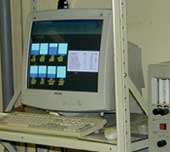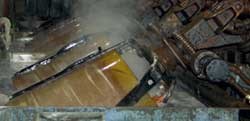The ABC’s of Success…
America’s Best Quality Coatings Corporation — a Milwaukee, Wisconsin-based plating job shop—has earned a reputation as one of the nation's biggest and best. Not to mention the fact that the company’s revenue per employee has doubled in the last four years. What’s its secret? A lean but flexible approach to tasks large and small…
#pollutioncontrol
In 1968, when the Milwaukee Bucks NBA basketball franchise was started, a contest was held in order to establish a team name. The winning name is said to have been suggested because bucks are “spirited, good jumpers, fast and agile.” That description—sans the part about good jumping—applies to another Milwaukee-based team: America’s Best Quality Coatings (ABQC). And like the playoff bound Bucks, ABQC is at the top of its game these days.
Established in 1920 as a metal-finishing facility for Allen-Bradley, a manufacturer of industrial automation equipment such as motors, rheostats and controls, ABQC was bought by a group of private investors in 1990 and converted to a stand-alone job shop. It functioned as a captive shop for Allen-Bradley, which now operates as a division of Rockwell Automation, until 1998, at which point it opened its doors to outside customers.
Featured Content
Located in downtown Milwaukee, ABQC employs 50 people and occupies a whopping 270,000 sq ft of real estate, making it one of the largest metal finishing job shops in North America.
Unlike many smaller job shops that might handle small to midsize projects for anywhere from 500-1,000 customers, ABQC’s market focus is primarily on work for large OEM’s. About one-third of the company’s plating business is in industrial controls and automation—attributed primarily to the shop’s continued relationship with Rockwell Automation—while another 25-30% of the business comes from the automotive industry. Approximately 20% of its projects are in the telecommunications and data storage industry, with the remainder composed of lawn and garden equipment and various other projects.
Though the majority of ABQC’s business revolves around zinc rack and barrel plating—which it offers in clear, yellow and black—the company provides a variety of plating services. They include tin plating, zinc and manganese phosphating, chromate conversions on zinc and aluminum die-castings, black oxide and specialty zinc work in a variety of colors. In addition, the company performs some mechanical-finishing operations, such as buffing, polishing, vibratory finishing and deburring.
Plating for Automotive
With more than one-fourth of its overall business coming from the automotive industry—typical projects include EMI protectors for car stereos, seating components, fuel rack end-plugs, locking mechanisms and oil pump housings—management at ABQC is acutely aware that business in the automotive industry is often accompanied by special demands and considerations.
First among these considerations is quality. “With automotive projects, it is important that our quality system is robust enough to meet the requirements of the TS [16949] system,” says Matthew Kirchner, ABQC’s president and CEO. TS 16949 is an enhanced version of QS 9000 that reflects the special demands of the automotive industry by focusing on defect prevention, waste reduction and constant improvement.
The second major consideration for plating automotive parts is delivery and turnaround time. ABQC’s customers carry as little inventory as possible, so delivery of plated parts on time is critical. “Making sure you are able to meet your commitments when it comes to delivery is absolutely important,” says Kirchner
The third factor, according to Kirchner, is cost. “Price is always going to be an issue in [the automotive industry]. But the approach that we try to take is from a total value or total cost perspective. We try not to get real bogged down in the piece price. We want to look at the cost to our customer of the overall relationship. That means that you’ve got a competitive piece price, that you are shipping quality parts, that you are shipping the parts on time and that your paperwork is accurate.”
A Lean, Flexible Approach
ABQC has focused on lean manufacturing for the last five years. During that time, training and employee incentives have played an increasingly important role in the company’s operations. A few years ago, the shop instituted an incentive plan that allows employees to share in the profitability of the business. If a work cell performs at or above a certain level, it can translate into a bonus. “You build in—through discipline and attitude out on the shop floor—a desire in your people to look for things to do more efficiently,” says Brian Stoddard, ABQC’s vice president and general manager.
Kirchner and Stoddard both agree that the nature of ABQC’s business has required the company to take a somewhat unique approach to becoming lean. For companies like ABQC, the actual plating process is more or less a fixed process. All of the steps in a plating process are there because they are necessary. There are no shortcuts. Instead, ABQC focuses on implementing lean manufacturing techniques into its ancillary processes. “We spend a lot of time on improving the logistics, such as getting the right parts to the line at the right time to meet the schedule we developed,” says Stoddard. “If we have tooling changes, how do we get the tools that we need to the person that’s putting them on at the right time and within the cycle time that we have set on the line? The lines that we have are heavily automated and they set the pace. Everything else has to fill in around that, and it’s those things that support the plating process that we spend our time on.”
For ABQC, the ability to communicate effectively with its customers plays an important role in the company’s implementation of lean manufacturing. “[Lean manufacturing] starts with understanding the whole value-stream map,” says Kirchner. “When we get into a new project with a customer, we spend a lot of time interviewing the customer in order to develop a thorough understanding of the project, which also gives both parties an opportunity to communicate their expectations about the project. It’s important to have an understanding of exactly how the parts are going to flow and who the players are in the flow. The whole key to lean manufacturing is waste elimination. If there is a step in that process that doesn’t need to be there, or that could be done more efficiently, that’s where you start the focus.”
Another component of ABQC’s lean approach to automotive plating is its Quantum Leap Forward (QLF) Team. The team is composed of a group of managers and meets every day for 30-60 min. In addition to reviewing line performance, the QLF Team also tackles a number of continuous improvement projects.
One recent project undertaken by the QLF Team consisted of a step-by-step time and motion study of one of the plant’s phosphating lines. The objective was to assess areas within the “choreography” of the line where efficiency was lacking and identify ways in which it could be improved. As part of the project, team members examined whether the barrels were being loaded with too much weight, looked at whether or not parts were being dried efficiently, and even worked with ABQC’s customers to assess whether or not improvements could be made in the way that parts are transferred from the customer’s containers into the barrels.
By all accounts, the institution of the QLF Team has had an enormous impact on ABQC’s success. Kirchner credits the team as being a key factor in the company’s ability to improve efficiency and boost revenue per employee, which he says has more than doubled in the past four years.
Complementing ABQC’s lean approach is a flexible ideology when it comes to responding to “out-of-the-box” customer requests.
Kirchner cites a recent example of his company’s flexible philosophy. “We were approached by a customer who wanted to have a brass automotive component plated with copper and then with tin. At the time, we did not have the capability to perform copper and tin on the same line.”
Rather than turn the customer away, ABQC evaluated the situation and weighed the costs of modifying the line against the potential benefits. In the end, Kirchner was able to work out a contract with the customer, which required ABQC to make an investment in the line to increase its flexibility (adding tanks, making the line longer, changing the PLC), but which also secured the customer’s business for a reasonable period of time.
Environmental Self-Discipline
ABQC’s self-regulation and commitment to training has not only made for a successful business atmosphere, it has also provided the job shop with a spotless environmental record, something that keeps it in the good graces of the Environmental Protection Agency (EPA), Department of Natural Resources (DNR) and the Milwaukee Metropolitan Sewage District (MMSD – the local POTW).
ABQC’s commitment to environmental compliance is epitomized by the company’s waste treatment facility, which ranks as one of the largest of its kind in existence in a metal plating facility. The system—rated to treat 500 gpm (ABQC generally runs it at about 200 gpm)—has the capacity to store three shifts worth of waste. Effluent discharge is tested using atomic absorption by ABQC’s environmental engineer on a daily basis and samples are sent to an outside laboratory for confirmation every month. Though self-discipline on this level can get a little pricey, the prevailing philosophy seems to be that it’s better to be safe than sorry. “There’s a fair amount of expense that goes along with that, but on the flip-side, you can get yourself into some serious trouble very quickly,” he says. This commitment to quality has earned ABQC a spot on the Milwaukee Metropolitan Sewage District’s “honor roll” for seven consecutive years.
In the waste treatment and chemistry laboratory, which doubles as a testing facility (complete with its own salt-spray and humidity testing chambers), operations are monitored and maintained from computer workstations, using a software program written by the company’s environmental team with the assistance of an outside consultant. From the workstation, employees can monitor virtually every aspect of the waste treatment facility. Data is recorded daily and stored in spreadsheets using Microsoft® Excel.
According to Stoddard, waste management is another area where ABQC’s approach has proven valuable. “Everybody has a hand in what happens in our waste treatment facility,” he says. “We’ve spent a lot of time training the supervisors and direct-hourly employees in the standards, protocols and practices that we have for protecting the facility.” All of that training, self-discipline and documentation also serves another goal—the achievement of ISO 14001 certification, something which the company hopes to accomplish by the end of 2004. “A lot of the bases are already covered,” says Stoddard. “It’s just a question of reformatting [our data] and filling in the spaces where we need to be compliant.”
With regard to process control, the chemical maintenance department performs detailed analysis on a predetermined basis for all process baths using atomic absorption, Hull cell testing and colorimetric titration. Results are plotted and tracked daily to ensure that all baths remain within the operating ranges necessary to process customer parts to requisite specifications. Integral to this system is a database known as the “Process Master” that documents all parameters of every production line down to a minute level of detail.
In preparing for ISO 14001 certification, the company is taking what might be described as an elastic approach, focusing initially on documenting its efforts within the job shop and waste treatment facility and then expanding outward to address ancillary environmental issues. “Our strategy has been to focus mainly on our perimeter [in the job shop], and we are spending most of our time on that,” says Stoddard. “But, as we get further from the perimeter of our site, we still have responsibilities as far as air quality, water consumption, trash reduction and related areas.”
Kirchner says that ISO 14001 is becoming increasingly important to their customers, especially in the automotive arena. “A big part of [the growing demand for ISO 14001 certification] is that as business becomes more and more sophisticated, we have seen that it’s more and more important to customers to know that they’re dealing with a first class operation,” he says.
RELATED CONTENT
-
Choosing and Troubleshooting Copper Electroplating Processes
Learn more on this inexpensive and highly efficient process.
-
An Overview of Electroless Nickel Plating
By definition, electroless plating is metal deposition by a controlled chemical reaction.
-
Copper Plating on Aluminum and Aluminum Alloys
How can I plate copper on aluminum?























